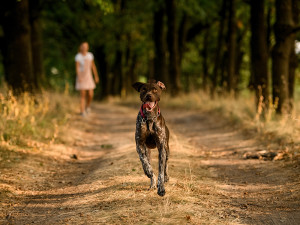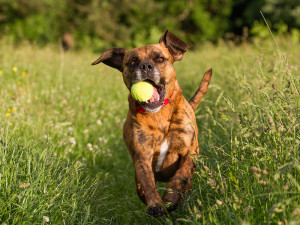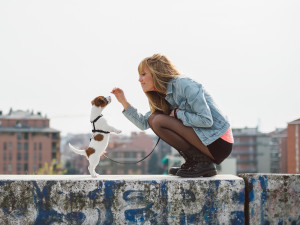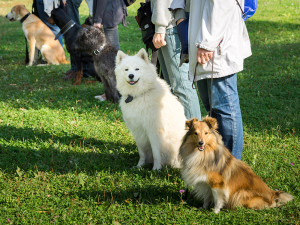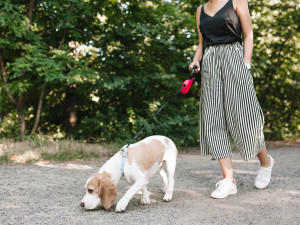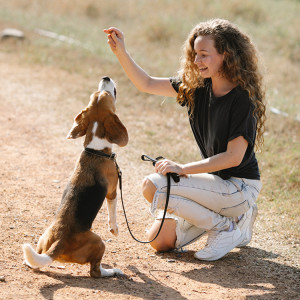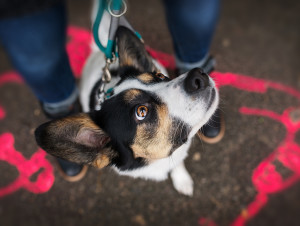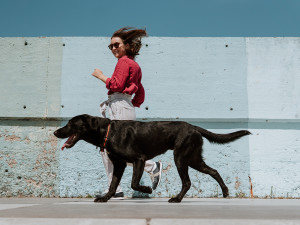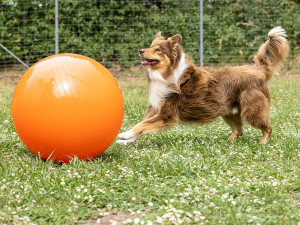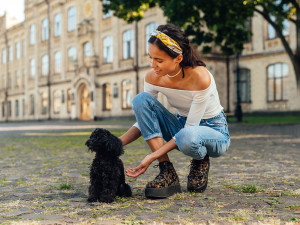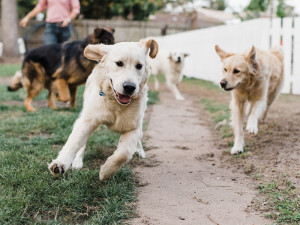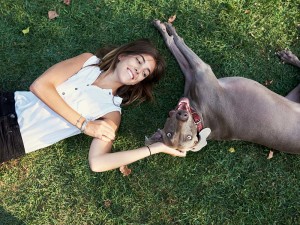7 Games That Can Actually Teach Your Dog Something
Cue the Schoolhouse Rock! because learning can be fun.
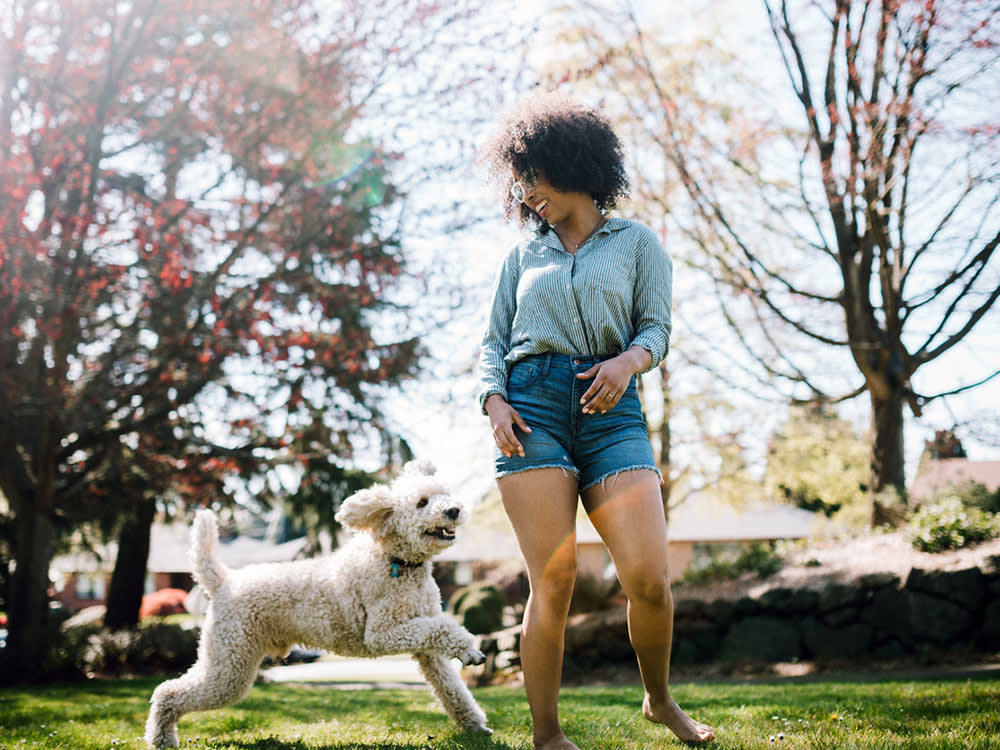
share article

Your pet wants you to read our newsletter. (Then give them a treat.)
If comedies like The Office and Abbott Elementary have taught us anything, it’s that work doesn’t always have to feel like work. Of course, most people don’t have entire camera crews following them around at their place of employment, but you get the point.
Training your dog can kind of feel like working on a mockumentary sitcom; you’re always working, but it doesn’t come without its funny, entertaining moments (but let’s maybe leave the circa 2005 Michael Scott jokes off the table). School is in session every time you interact with your dog — even during lighthearted play, they are always learning. Here are seven games that’ll teach your dog valuable lessons and help them be upstanding members of society — all while having a blast.
1. Chase (you)
Consider this game if you’re convinced that your dog doesn’t like to play; once they’ve been enticed into a game of chase, you may see their fun side come alive.
Another plus: When you want to reward your dog but have no treatsopens in a new tab or toys handy, chase can be a go-to way to make your dog glad they listened to you. And, because it teaches your dog to move toward rather than away from you, it can help with recall trainingopens in a new tab. Importantly, your dog must always chase you, not the other way around. Never chase your dog; it will teach them to run away when you approach and ruin their recall.
While “chase” can easily turn into the not-so-wise-or-fun game of “let’s nip the human’s ankles, legs, or behind,” for the right dog played the right way, it can be a fantastic way to teach your dog to pay attention to you because you’re fun. Change directions often, and to avoid trouble with an aroused dog becoming mouthyopens in a new tab, stop running before your dog gets to you.
One caveat: I advise against children playing this game unless the dog has a proven record of being able to handle it without becoming overstimulatedopens in a new tab, and even then, only with adult supervision.
2. Fetch
When we think about playing with dogs, this is the game that most often comes to mind. Fetchopens in a new tab is a cooperative activity, and each player has a role that must be fulfilled for it to work. (Many people tell me that their dog loves to play fetch and then go on to say that the dog chases the ball but won’t bring it back, or won’t drop it. That’s not fetch — that’s running after a ball and hoarding it.)
Fetch has a lot to offer, including the skill of dropping an item upon request. It also provides opportunities to work on high-level obedience training. After a few throws, during which the dog has retrieved an item, brought it back to you, and dropped it at your feet, take a short break and ask them to do something specific: sit, down, high-five, or any behavior they can do on cue. Then resume play. Adding this mental stimulation into a game of fetch can be done sporadically so that most sessions are pure fun and games for your dog.
By switching between the excitement of running and the discipline of responding to a cue, the dog learns to transition between high arousal and being calm. Teaching dogs to have an on/off switch develops emotional control that will serve them well throughout life. (Another perk: Your dog gets exercise without much effort on your part, which is particularly appealing when you just want to enjoy your morning coffee while your dog burns up some energy.)
3. Find Your Treats
Dogs have a lot of fun with this deceptively simple treasure hunt, but the “treasure” must be something your dog cares enough about to search for. Nose workopens in a new tab gives your dog mental stimulation, keeps them occupied for a while, and is a great party trick that allows your dog to show off.
Begin by putting some treats on the floor or furniture without your dog seeing you do it. Say the cue (“find it” or “find your treat” are frequently used) and tap or point to the treats. Repeat…a lot…over many days or weeks. When your dog starts to look for the treats upon hearing the cue, drop the tap or point. Once your dog is familiar with the game, have them stay, then release them to find the treats. At first, hide the treats before you ask them to stay; after your dog’s stay is solid, you can have them do so while you hide the treats, either within sight or even in another room.
Caveat: If your dog is a food-guarder, skip this game. Also, it may teach your dog to sniff around and get into stuff.
4. Hide-and-Seek
Here’s another enrichment game that teaches your dog to go on a search, but with you as the focus of the quest. It’s a great way to practice and improve a dog’s ability to come when called. To play, they must already know what “come” means.
Begin indoors. Call your dog when you are partially out of sight, perhaps crouched down next to a piece of furniture or behind a plant that doesn’t entirely conceal you. When your dog finds you, reinforce them with top-quality stuff — treats, a toy, a bone, a chew, play time, or a walkopens in a new tab. Gradually work up to more obscure hiding spots, until you can be completely hidden from sight when you call her.
Add in “stayopens in a new tab” practice by putting your dog on a stay, hiding, then releasing them and calling them to come. For many dogs, the anticipation of being released makes them respond even more enthusiastically when called.
Expect your dog’s recall to improve dramatically if you play this game on a regular basis. You are teaching your dog that “come” means to do it even if you are not in plain view, and because it’s a game with reinforcements, dogs find it fun and worthwhile.
Playing this game when you are out in a (safe) off-leash area teaches your dog to keep an eye on you, and helps them understand that if the two of you become separated, they should look for you. And vice-versa — it’s not one-sided.
Caveat: Disappearing around an aloof dog outside may not prompt any concern at all, and disappearing from view around a clingy dog anywhere may be upsetting.
5. Family Circle
This is a special kind of hide-and-seek in which dogs are told to find a specific person. To play, the dog needs to understand and respond to the “come” cue and you’ll need a few people.
First, have someone else call out your name: “Where’s Karen?” After that, you should call the dog. If they come to you, they get reinforced, but if they go to somebody else, they get ignored. Once you have rewarded your dog for finding you, ask them to find another person. For example, say, “Where’s Rob?” and then Rob should call the dog to come.
Most dogs learn people’s namesopens in a new tab quickly and begin to head to the right person once they hear the name, even before the cue. At that point, you can mix it up — sometimes calling them to come (to maintain a strong recall), sometimes saying only “Where’s [name]?” Once the dog can succeed in that context, up the stakes by having people stay out of sight, perhaps in other rooms, so the dog needs to search.
Learning the names of everyone in the family is more than just a cool party trick or a practical way to locate someone. It’s also another way to give the dog exercise without a lot of work on your part.
6. Tug
There are many reasons to play tug with dogsopens in a new tab, and one of the most obvious is that so many of them love it. More reasons: it’s interactive, it’s a way to provide a dog with exercise in a relatively small space, and it can help them stretch before another activity or rev them up before a competition (if that leads to a better performance).
The game requires that a dog knows (or learns) how to respond to cues to take a toy and to drop it, which are related skills. Incorporated into the game itself, they are easier to teach. The game is the reward for taking an object, and dropping it can be reinforced with a treat and then resuming the tugging.
These skills can be useful in real life as well. Use “take it” when you want your dog to carry something small for you, or “drop it” when they’ve gotten hold of, say, the title to your car, which actually happened to a client of mine.
With tug, many dogs also learn to control their mouths and the emotions that can cause their mouths (and the rest of them!) to spiral out of control. Contrary to once-popular opinion, it will not make a behaviorally stable dog “turn aggressive.”
Caveat: This game can be problematic for dogs who guard objects or those who become aggressive when highly aroused. It’s best for dogs who do not struggle with impulse control or bite inhibitionopens in a new tab.
7. Red Light, Green Light
This one, borrowed from a game enjoyed by children, teaches dogs to listen to cues even when excited. The impulse control involved in repeatedly stopping and starting is a great life skill that often spreads to other contexts. Sometimes, a dog who is having trouble with self-control will be able to pull it together after several of the transitions between the excited running and stopping that make up the core of this game. Other dogs calm down if you play it in a very tranquil, slow manner. Different styles of the game work best for different dogs.
It can be played one-on-one in the living room or during a walk, or in teams in a class setting, with multiple dogs competing to reach a finish line. In order to play, the dog needs to be able to watch the human member of the team and respond to a “sit” or “down” cue.
When they hear “green light,” dogs walk or run next to their human. When they hear “red light,” they must stop and lie down or sit (depending on the skill being worked on and which cue the dog is capable of responding to).
When the game is played in class, if the dog is unable to lie down or sit on cue within three to five seconds, the team pays a penalty — taking three steps backward or returning to the start line, for example.
There is more to playing with our dogs than just having a good time, though that’s certainly enough to make it worthwhile. While you and your best friend are having fun, the game serves double duty as a practical way to teach important skills.

Karen B. London, PhD, CAAB, CPDT-KA
Karen B. London, Ph.D., is a Certified Applied Animal Behaviorist and Certified Professional Dog Trainer who specializes in working with dogs with serious behavioral issues, including aggression, and has also trained other animals including cats, birds, snakes, and insects. She writes the animal column for the Arizona Daily Sun and is an Adjunct Professor in the Department of Biological Sciences at Northern Arizona University. She is the author of six books about training and behavior, including her most recent, Treat Everyone Like a Dog: How a Dog Trainer’s World View Can Improve Your Lifeopens in a new tab.
Related articles
![Owner and black dog running outside against blue backdrop]() opens in a new tab
opens in a new tab5 Running Games to Play With Your Dog
A few minutes — or even a few steps — are all you need to add joy to your dog’s day.
![A border collie playing Treibball with an orange ball.]() opens in a new tab
opens in a new tab“Urban Herding” Can Burn Your Dog’s Energy
If your dog needs a job, trainers recommend Treibball.
- opens in a new tab
“How Can I Calm My Super Jumpy Dog?”
The Wildest Collective dog trainer Robert Haussmann’s pro tips for getting a hyped-up dog to chill out.
![A woman wearing a yellow headband and a white off-the-shoulder shirt with blue jeans and platform black flower boots kneeling next to her black Poodle mix dog on the lawn outside]() opens in a new tab
opens in a new tabHow to Teach Your Dog Your Name
Your dog might not know your name. Don’t take offense; just play this game.
![Golden retriever dogs chasing each other through a yard in play.]() opens in a new tab
opens in a new tabThe Unexpected False Advertising of Public Dog Parks
These apparent canine meccas can pose real risks to your dog’s overall safety.
![Female dog trainer raising a treat above a beagle dog's head]() opens in a new tab
opens in a new tabYour Dog’s Trauma Triggers Are Everywhere. Fear-Free Training Can Help
“America’s Veterinarian” and the founder of Fear Free Pets, Dr. Marty Becker, on how this method makes vet visits, training sessions, and grooming appointments less stressful for pets.
![Woman laying on the grass smiling at her dog]() opens in a new tab
opens in a new tab10 Ways to Make Your Dog’s Life Better
Number 6 will probably surprise you.
